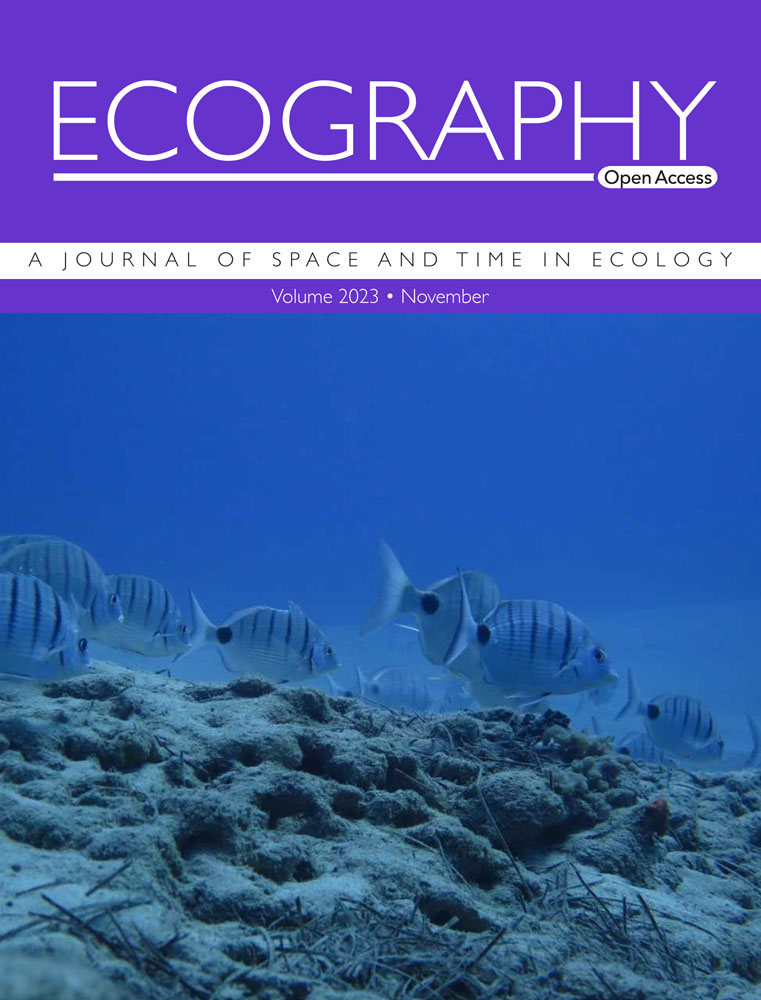A test of the abundant‐center hypothesis for stream fishes
IF 5.4
1区 环境科学与生态学
Q1 BIODIVERSITY CONSERVATION
引用次数: 0
Abstract
The abundant‐center hypothesis (ACH) provides a conceptual model for predicting range‐wide distributions of species abundance, suggesting that abundance peaks in the center of the geographic range and declines towards range edges. Empirical studies testing the ACH and its subsequent derivations predominantly occurred in terrestrial systems and reported mixed support. Moreover, none of these models consider the possibility of multiple geographic areas of elevated abundance (which we refer to as ‘abundant cores'). Naturally dispersal limited species may exhibit multiple abundant cores, requiring refinement of the ACH. We used fish species abundances from 29 206 community monitoring surveys and weighted geospatial kernel density estimation to identify the number of abundant cores for 64 freshwater fish species. We regressed the number of abundant cores against range size and body size to test if larger geographic distributions and body sizes contain more abundant cores than smaller distributions and body sizes. The two predictors are surrogates for evolutionary age and dispersal ability, respectively, because older species are generally associated with larger ranges, and large‐bodied fishes have greater dispersal ability than small‐bodied fishes in dendritic networks. For studied species, 43 exhibited multi‐core distributions, and 21 exhibited a single‐core distribution. Species range size, but not body size, was significantly and positively associated with the number of abundant cores. The ACH was not a good descriptor of the abundance patterns of most stream fishes we studied, suggesting that an abundant center model may not be well‐suited for freshwater fishes. Recent geo‐climatic events in evolutionary time have isolated populations of the same species by a matrix of unsuitable habitat and/or hard dispersal barriers, providing the basis for multi‐core distributions. Biogeographic and ecological mechanisms likely underpin observed multi‐core patterns, and our work indicates that the ACH and related concepts still present opportunities for testing and refinement.流鱼类丰中心假说的检验
丰度中心假说(abundant - center hypothesis, ACH)为预测物种丰度在全范围内的分布提供了一个概念模型,表明物种丰度在地理范围的中心达到峰值,并向范围边缘下降。测试ACH及其后续衍生的实证研究主要发生在陆地系统中,并报告了混合支持。此外,这些模型都没有考虑到多个地理区域丰度升高的可能性(我们称之为“丰富的核心”)。自然分散的有限物种可能表现出多个丰富的核心,需要改进ACH。利用29206个群落监测调查的鱼类丰度和加权地理空间核密度估算,确定了64种淡水鱼的丰富核数。我们将丰富的岩心数量与范围大小和体型进行了回归,以检验较大的地理分布和体型是否比较小的分布和体型包含更多的岩心。这两个预测因子分别是进化年龄和扩散能力的替代品,因为年龄较大的物种通常与更大的范围相关,而且在树突网络中,大型鱼类比小型鱼类具有更大的扩散能力。其中43种为多核分布,21种为单核分布。物种范围大小与丰富岩心数量呈显著正相关,而体大小与丰富岩心数量呈显著正相关。ACH并不能很好地描述我们所研究的大多数溪流鱼类的丰度模式,这表明丰度中心模型可能不太适合淡水鱼类。在进化时期,最近的地质气候事件通过不适宜的栖息地和/或硬扩散屏障将同一物种的种群隔离开来,为多核分布提供了基础。生物地理和生态机制可能是观察到的多核心模式的基础,我们的工作表明ACH和相关概念仍然存在测试和完善的机会。
本文章由计算机程序翻译,如有差异,请以英文原文为准。
求助全文
约1分钟内获得全文
求助全文
来源期刊

Ecography
环境科学-生态学
CiteScore
11.60
自引率
3.40%
发文量
122
审稿时长
8-16 weeks
期刊介绍:
ECOGRAPHY publishes exciting, novel, and important articles that significantly advance understanding of ecological or biodiversity patterns in space or time. Papers focusing on conservation or restoration are welcomed, provided they are anchored in ecological theory and convey a general message that goes beyond a single case study. We encourage papers that seek advancing the field through the development and testing of theory or methodology, or by proposing new tools for analysis or interpretation of ecological phenomena. Manuscripts are expected to address general principles in ecology, though they may do so using a specific model system if they adequately frame the problem relative to a generalized ecological question or problem.
Purely descriptive papers are considered only if breaking new ground and/or describing patterns seldom explored. Studies focused on a single species or single location are generally discouraged unless they make a significant contribution to advancing general theory or understanding of biodiversity patterns and processes. Manuscripts merely confirming or marginally extending results of previous work are unlikely to be considered in Ecography.
Papers are judged by virtue of their originality, appeal to general interest, and their contribution to new developments in studies of spatial and temporal ecological patterns. There are no biases with regard to taxon, biome, or biogeographical area.
 求助内容:
求助内容: 应助结果提醒方式:
应助结果提醒方式:


